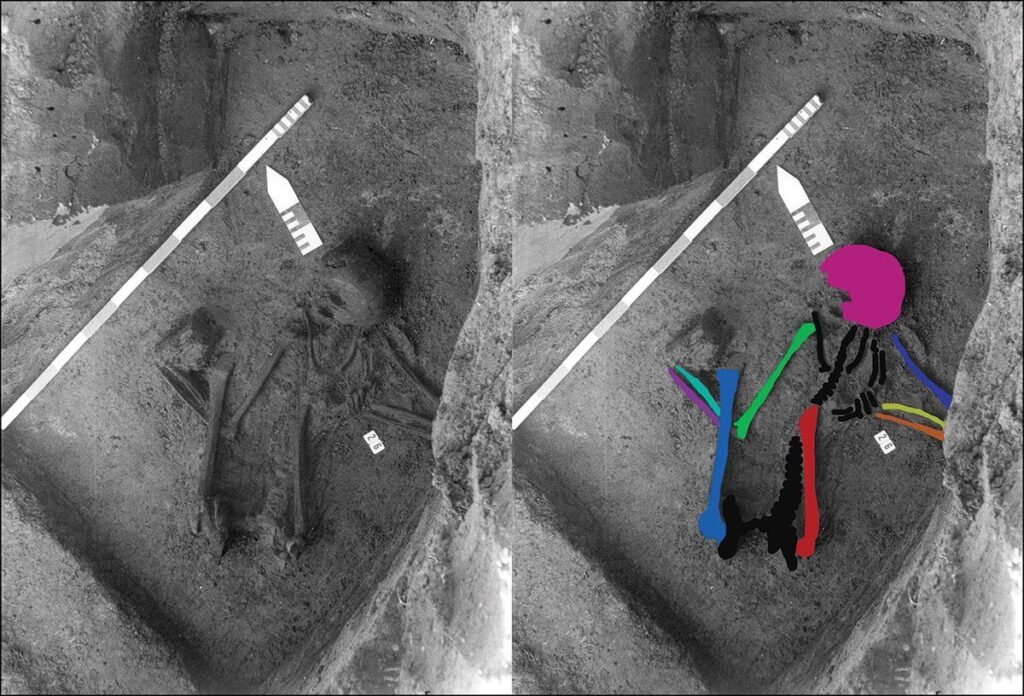Researchers performed DNA testing on the bones highlighted in this image.
Paumen, Wargnies and Demory / Fédération Wallonie-Bruxelles / Veselka et al.
Back in the 1970s, when archaeologists excavated a skeleton from an ancient graveyard in Belgium, they thought they had found a typical Roman burial. But during a recent reexamination of the bones, researchers noticed peculiarities. For instance, the skeleton’s spine appeared to be made of both adolescent and adult vertebrae.
“I started thinking, okay, something really weird is going on,” researcher Barbara Veselka, an archaeologist at the Free University of Brussels, tells New Scientist’s Christa Lesté-Lasserre.
Veselka’s team used radiocarbon dating to analyze the individual bones; they also sequenced ancient DNA found in them. They found that the skeleton is made of bones from at least eight unrelated men and women, according to a recent study published in the journal Antiquity.
The skeleton contained these five adult foot bones and two adolescent toe bones.
Veselka et al.
The skeleton was found in the town of Pommerœul, near Belgium’s border with France. Placed in the fetal position, it was the only intact body in a graveyard containing 76 cremation burials. Because of a bone pin found near the head, researchers initially concluded the burial was Roman, dating to the second or third century C.E., when the Roman Empire covered the Gallic lands of present-day France and Belgium.
The skeleton’s bones are actually much older, with the earliest “contributor” dying nearly 4,445 years ago, per New Scientist. The skeleton contains bones from multiple generations in the late Neolithic period, who lived thousands of years before the Romans conquered Gaul.
Still, the skeleton isn’t completely out of place in the Roman cemetery. According to genetic analysis, its skull belongs to a Roman woman of the third or fourth century C.E., whose DNA matches similarly-aged Roman remains in a nearby cemetery—probably siblings.
How did this composite Neolithic skeleton end up with a Roman skull more than 2,000 years later? As the researchers write, Gallo-Roman groups may have disturbed the old burial while interring their own dead. If it was headless, the Romans might have “completed” it by adding a skull of their own. If not, maybe they replaced the skull. Or maybe they created the entire amalgamated skeleton themselves.
Our paper is out! Want to know more about unusual burial practices in the Late Neolithic AND Gallo-Roman time? You can read all about it in our open access publication!https://t.co/vPnQJVAL9F
— Dr Barbara Veselka (@VeselkaBarbara) October 23, 2024
“Whether the assembly of the bones occurred in the late Neolithic or in the Roman period, the presence of the ‘individual’ was clearly intentional,” write the researchers. “The bones were selected, a fitting location chosen and the elements arranged carefully to mimic the correct anatomical order.”
Whoever composed the burial understood enough about the human skeletal structure to create a convincing puzzle. As Veselka tells New Scientist, “They knew what they were doing, for sure.”
As Jane Holmstrom, a bioarchaeologist at Macalester College who wasn’t involved in the research, tells Live Science’s Kristina Killgrove, this “fascinating and complex” study may help illuminate Neolithic burial customs. Veselka notes that Pommerœul was located near a river—an enduring mark of geographic and spiritual importance. Various groups over time may have wanted to control it.
The composite skeleton “provides an interesting possibility of land-claiming through burial during the Neolithic,” Holmstrom adds, “with family groups within the clan asserting claim together, with the Romans furthering the land claim to assert their authority over Gaul.”


